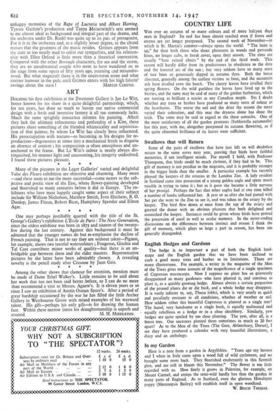COUNTRY LIFE
WAS ever an autumn of so many colours and of more halcyon days seen in England? Its end has been almost reached even if frosts and storms are yet longer postponed. The second week of November—in which is St. Martin's suminer—always opens the world. " The hunt is up," for then both those who shoot pheasants in woods and persuade foxes, no longer cubs, to break Lover, open their season. The elms are usually " bare ruined choirs " by the end of the third week. This season will hardly differ from its predecessors in obedience to the date and the lowered arc of the sun ; but very seldom have so many sorts of tree been so generously dipped in autumn dyes. Both the horse chestnut, generally among the earliest victims to frost, and the mountain ash have rivalled even the beech. The cherry leaves have rivalled their spring flowers. On the wild guelders the leaves have lived up to the berries, and the same may be said of many of the garden barberries, which are turning as brilliant a scarlet as any Canadian maple. Yet I doubt whether any trees or bushes have produced so many sorts of colour as the hawthorns. The worse the soil and the drier the season the more varied their coloration, and this year the dryness alone has done the trick. The same may be said in regard to the three sumachs. One of the most satisfactory of all the garden prunuses (Subhirtella autumnalis) has this year, with me, altogether postponed its autumn flowering, as if the quite abnormal brilliance of its leaves were sufficient.






























 Previous page
Previous page